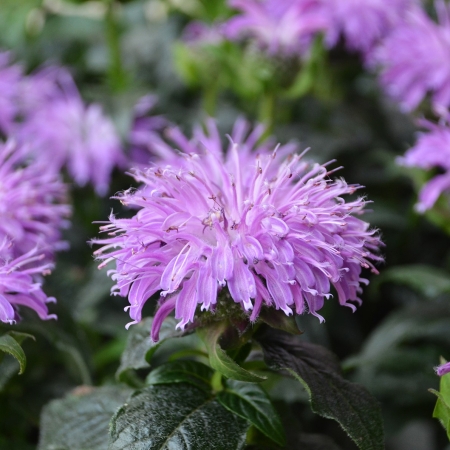Monarda (Bee Balm)
×
Color Name: Blue Moon
Monarda Blue Moon is a captivating perennial renowned for its soft, lavender blue flowers. Blue Moon is perfectly suited for the middle of the flower border at 16-24" tall. This aromatic plant boasts deep green foliage and thrives in sunny to partially shaded areas, making it an ideal addition to garden borders or mixed flower beds. Monarda not only adds stunning color but also contributes to a flourishing ecosystem, making it a delightful choice for garden enthusiasts.
Monarda is native to eastern North America, so it is easy to grow and it multiplies quickly. The flowers' sweet nectar attracts scores of hummingbirds, butterflies, and bees to the garden. The aromatic foliage smells like mint when crushed and is often used to flavor teas.
Growing Tips: Monarda can be found naturally along riverbanks and enjoys this rich, organic, moist soil. However, it will grow in average soil as well. Full sun is best, but light shade is tolerated. Plants tend to spread more quickly in the shade, however.
Most monardas multiply rapidly either by underground stems or self-sowing. Deadheading spent blooms will prolong the bloom time.
Powdery mildew is a common fungal problem with monarda. Some varieties are more resistant to it than others. To prevent this fungus from appearing, large clumps should be thinned out so that the air circulates freely around them. The soil should also be kept consistently moist; dry soil promotes powdery mildew.
Photo courtesy of Walters Garden, Inc.
Monarda Blue Moon is a captivating perennial renowned for its soft, lavender blue flowers. Blue Moon is perfectly suited for the middle of the flower border at 16-24" tall. This aromatic plant boasts deep green foliage and thrives in sunny to partially shaded areas, making it an ideal addition to garden borders or mixed flower beds. Monarda not only adds stunning color but also contributes to a flourishing ecosystem, making it a delightful choice for garden enthusiasts.
Monarda is native to eastern North America, so it is easy to grow and it multiplies quickly. The flowers' sweet nectar attracts scores of hummingbirds, butterflies, and bees to the garden. The aromatic foliage smells like mint when crushed and is often used to flavor teas.
Growing Tips: Monarda can be found naturally along riverbanks and enjoys this rich, organic, moist soil. However, it will grow in average soil as well. Full sun is best, but light shade is tolerated. Plants tend to spread more quickly in the shade, however.
Most monardas multiply rapidly either by underground stems or self-sowing. Deadheading spent blooms will prolong the bloom time.
Powdery mildew is a common fungal problem with monarda. Some varieties are more resistant to it than others. To prevent this fungus from appearing, large clumps should be thinned out so that the air circulates freely around them. The soil should also be kept consistently moist; dry soil promotes powdery mildew.
Photo courtesy of Walters Garden, Inc.
|
Flower Color: Purple Shades Foliage Color: Green Shades
Height: 16 to 22 Inches Spread: 18 to 22 Inches Hardy in Zone: 4, 5, 6, 7 |
Blooms: Late Summer Mid-Summer
Foliage Season: All Season |
Growth Rate |
Medium
|
Attributes |
Extended Bloomer Fragrant Native Border Cut Flower or Foilage Disease Resistant Easy to Grow Landscapes Mass Planting
|









